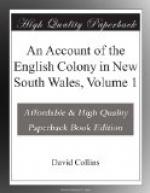On board of the Daedalus were embarked at Monterrey, a Spanish settlement at a short distance from Nootka, six bulls, twelve cows, six rams, and eight ewes; and at Otaheite, Lieutenant Hanson took on board upwards of one hundred hogs (most of them, unluckily, barrows) of all which stock four sheep and about eighty hogs only survived the passage. The loss of the cattle was attributed to their having been caught wild from the woods, and put on board without ever having tasted dry food. The major part of the hogs, apparently of a fine breed, arrived in very poor condition.
Lieutenant Hanson, having touched at the northernmost island of New Zealand, brought away with him two natives of that country, having received directions to that effect for the purpose of instructing the settlers at Norfolk Island in the manufacture of the flax plant. They were both young men, and, as they arrived before the departure of the Shah Hormuzear, the lieutenant-governor determined to send them at once to Norfolk Island.
Captain Vancouver transmitted by Lieutenant Hanson a chart and drawings of a spacious harbour, which he discovered on the southwest coast of this country, and which he named King George the Third’s Sound. Its situation was without the line prescribed as the boundary of the British possessions in this country, being in the latitude of 35 degrees 05 minutes 30 seconds South, and longitude 118 degrees 34 minutes 0 seconds E. He also sent an account of the discovery of a dangerous cluster of rocks, which he named the Snares, the largest of which was about a league in circuit, and lay in latitude 48 degrees 03 minutes S and longitude 166 degrees 20 minutes East, bearing from the South-end of New Zealand S 40 degrees W true, twenty leagues distant; and from the southernmost part of the Traps (rocks discovered by Captain Cook) S 671/2 degrees W true, twenty leagues distant. The largest of these rocks, which was the highest and the northeasternmost, might be seen in clear weather about eight or nine leagues: the whole cluster was composed of seven barren rocks, extending in a direction about N 70 degrees E and S 70 degrees W true, occupying the space of about three leagues.
The Chatham, being separated in a gale of wind from the Discovery, fell in with an island, which was named ‘Chatham Island,’ and along the north-side of which she sailed for twelve leagues. Its inhabitants much resembled the natives of New Zealand, and it was situated in latitude 43 degrees 48 minutes S and longitude 183 degrees 02 minutes East.
We learned from Lieutenant Hanson, that the Matilda whaler, which sailed hence in the latter end of the year 1791, on her fishing voyage, was wrecked on a reef in 22 degrees South latitude, and 138 degrees 30 minutes West longitude. The master and people reached Otaheite, from whence some were taken by an American vessel, and some by Captain Bligh of the Providence. Five sailors only remained on the island, with one runaway convict from this place, when the Daedalus touched there in her route hither, and of that number one sailor only could be prevailed on to quit it.




